|
Back to Webletter
SPHPMS
By Donna Speidel
In our last webletter, we promised a review of the new standard for the holding position marking.
(We know it's been difficult to contain your excitement, but the wait is over!) For all of the Acronym Enthusiasts out
there, this article is right up your alley regarding Surface Painted Holding Position Marking Signs... AKA SPHPMS's.
Bookmark this page for future reference, we promise it will be here when you need it again!
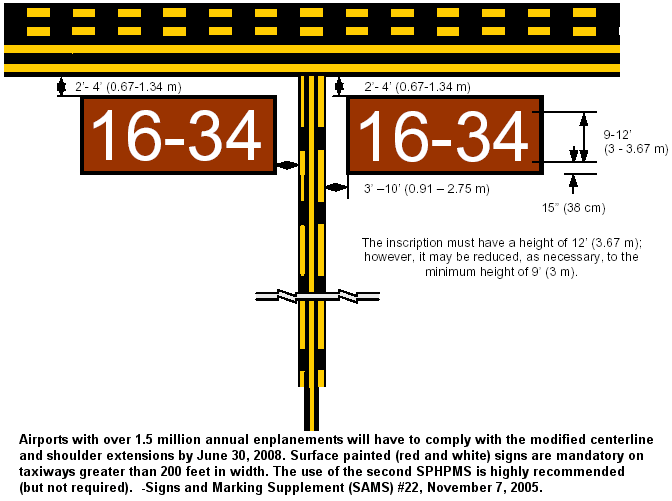
There are three different aspects to the new marking, some of which will be at the discretion
of the airport, some of which is mandatory for certain sized airports.
- Modify the taxiway centerline - mandatory on airports with over 1.5 million annual enplanements.
- Extend the holding position marking onto the taxiway shoulder (if any) - mandatory on airports with over
1.5 million annual enplanements.
- And now for the SPHPMS: Add the red and white surface painted holding position signs on both sides of the taxiway centerline -
discretionary on taxiways less than 200-feet wide; mandatory on taxiways over 200-feet wide.
The intent of the new markings is to increase conspicuity and situational awareness of this particularly
dangerous area that is more susceptible than any other to runway incursions.
So what exactly has to be done?
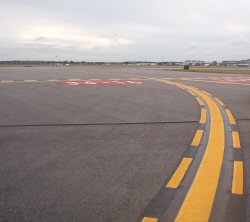
- Modify the taxiway centerline marking from the holding position marking back toward the taxiway 150-feet
is mandatory. Whatever the width of the current taxiway centerline, 15 to 18-inches of black paint must be added
to each side of the existing taxiway centerline. Once the black paint has been added, the 6-inch wide by 9-foot
yellow dashes separated by a 3-foot space, must be laid out, again beginning at the holding position marking and
working back toward the taxiway. If the taxiway centerline is on a curve, the spacing should be measured from
the actual center of the existing centerline, marking the beginning and end of each dash on center. An imaginary
line drawn perpendicular to the marks for the dashes would represent the start and stop points so that the dashes
and spaces remain even. (See FAA AC150-5340, 1J, Signs and Marking Supplement (SAMS) #23 dated January
10, 2006.
This modification to the taxiway centerline is required for all airports with 1.5 million annual enplanements,
and must be in place by June 30, 2008.
- Extending the holding position marking to within 5-feet of the taxiway shoulder edge (or light fixture) up to
25-feet long is also a requirement for airports with more than 1.5 million annual enplanements, and must be in
place by June 30, 2008. The intent of extending the holding position marking onto the shoulder is to provide
more visual cues to the pilot in a high cockpit, as well as any vehicle driver who may be maneuvering on the
shoulders and might otherwise miss the marking and wander onto the runway without permission. (Additional
pictures can be found at the bottom of this page).

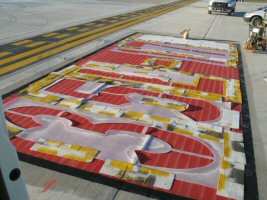
- Surface painted holding position signs are already required on the left side of the taxiway centerline on
taxiways over 200-feet wide at the holding position marking. AC 150/5340-1J states that on taxiway surfaces over
200-feet, the surface painted signs should be placed on both sides of the taxiway centerline, affording greater
conspicuity and situational awareness for all those operating on the flightline.
These markings are going to be labor intensive, may require up to four different colors to apply them
and may take a considerable amount of time to work the marking patterns into the airfield/taxiway geometry.
As you can see from the pictures, it is a time-consuming process.
 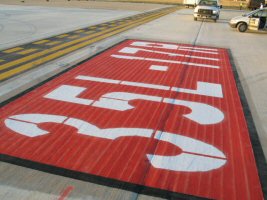
A note to the engineers: when designing a project that includes surface painted signs,
whether SPHPMS, Location, or Direction signs, list them as a separate line item, as the detail involved should not be
quoted by the square foot; it should be per each.
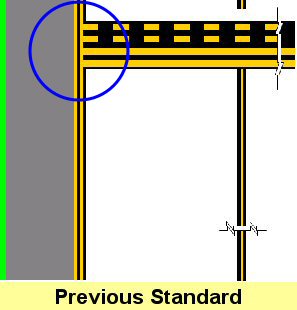 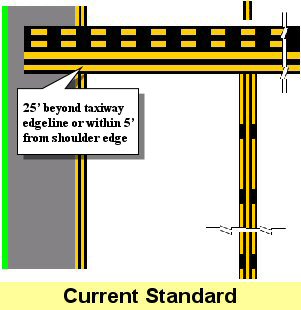
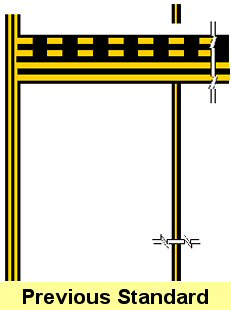 
Back to Webletter
|












